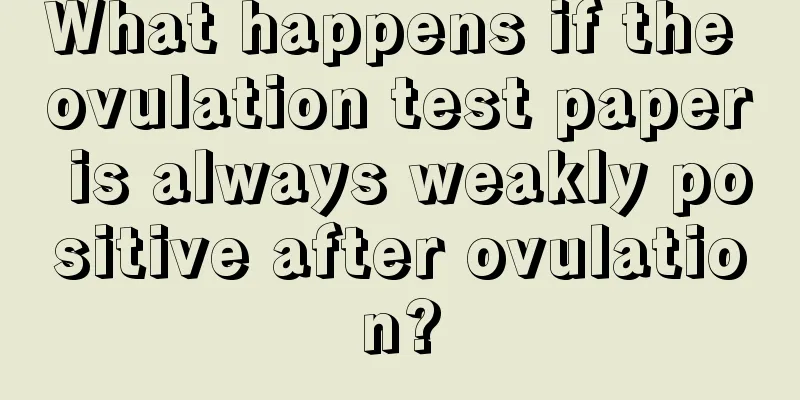What happens if the ovulation test paper is always weakly positive after ovulation?

|
Having children is something that women will do when they reach a certain age. When you are mentally prepared to be a mother, the next step is to get pregnant and have a baby, so you will plan when the best time for ovulation is, and then test when the ovulation period is good. Ovulation test strips can be used for testing. Ovulation test strips, whose generic name is luteinizing hormone test strips (colloidal gold immunochromatography), are used to qualitatively detect luteinizing hormone (LH) in human urine, thereby determining the time of ovulation and the "safe period" in a woman's menstrual cycle, so as to choose the best time for conception or use the "safe period" for contraception. It is an in vitro test and auxiliary diagnosis of a woman's ovulation period. Next, we will introduce to you what happens if the ovulation test paper is always weakly positive after ovulation? If the ovulation test paper is always weakly positive, only a red strip appears in the control line area or the test line is lighter than the control line. If a red strip appears, that is, the control line is colored and the test line is not colored, it means there is no ovulation; if two red strips appear and the test line is obviously lighter than the control line, it means that the LH in the urine has not yet reached a peak and daily testing must be continued. How to use ovulation test strips: Step 1: Menstrual Cycle The number of days from the first day of menstruation to the day before the next menstruation is a menstrual cycle, which is generally 26 to 35 days. Prepare a menstrual cycle chart for yourself. Record the first day of your menstrual period every month. The time between two menstrual periods is a menstrual cycle. You need to record for three or four months to accurately calculate the menstrual cycle. Ovulation day: It takes one or two days for the mature egg to travel from the ovary through the fallopian tube and into the uterus, but these 48 hours seem so short. It usually occurs about 14 days before the next menstrual period. Dangerous period: These 48 hours are definitely a high-risk period for pregnancy, but it does not mean that all will be fine if you have sex during these two days, because sperm is a tenacious hunter. It can survive for about 72 hours after entering the uterus and will lurk in the uterus for three days to capture the newly appeared eggs at any time. Therefore, the 3 days before and after ovulation, a period of about 7 days including the ovulation day, are locked as the dangerous period, which is also the period when it is easy to get pregnant. The remaining days without menstruation are the safe period. Step 2: How to lock in the dangerous period The key is to find the days in the middle of your period first. It’s not complicated, just do kindergarten level arithmetic problems. Just subtract 17 from the shortest cycle and 11 from the longest menstrual cycle and you will get the answer. For example, if the menstrual cycle is 30-32 days, use 30-17=12, 32-11=21, and the safe period is 13-21 days. Circle these days in a big red circle. During this period, if you use an ovulation test strip to test, a positive reaction will indicate that you are approaching your high-risk fertility period. Step 3: How to do it According to the above method, you should first conduct tests for at least 3 months and then make pregnancy plans after you understand the regularity of your cycle. That is, during the dangerous period, you should use ovulation test strips to test before having sex every day. A positive reaction indicates that you are about to enter the high-risk pregnancy period. Once you have an accurate grasp of your menstrual cycle, start taking action. Just arrange some intimate activities 3 days before ovulation and 3 days after ovulation. Through the editor's article, I believe everyone has a certain understanding of what happens when the ovulation test paper is always weakly positive after ovulation, so when choosing the best time to conceive, you must also understand what is going on. The ovulation test paper mainly measures the hormone luteinizing hormone (LH) in the female body, and detects the peak level of luteinizing hormone, so that women can predict the best time for conception or contraception. I hope my article can help you. |
<<: At what age do women enter menopause?
>>: How to prevent sagging breasts while breastfeeding?
Recommend
30 weeks premature baby picture
Every pregnant mother hopes to give birth to a he...
Can I sing while I am menstruating?
Most people can't help but hum a few lines wh...
How is your breathing? ——Defeat the sequelae of COVID-19, practice respiratory rehabilitation at home
Hey! Hello, everyone~ First of all, let us warmly...
What are the contraceptive methods?
Nowadays, people are becoming more open-minded, a...
Why is vaginal discharge yellow?
Gynecological diseases are common diseases among ...
How to detect if your period is coming?
Women are very familiar with menstruation, it is ...
Is it normal to have frequent fetal movements in the fourth month of pregnancy?
After a pregnant woman becomes pregnant, she can ...
Is breast enhancement cream harmful to the body?
In life, many women with small breasts will try a...
What causes brown discharge from the vagina?
The secretions from the genitals are usually yell...
Attention! These 6 foods are highly toxic. Don’t keep them, let alone eat them! Throw them away immediately!
In life, many foods are delicious when they are n...
How to treat kidney yin deficiency and uterine coldness?
If women find themselves suffering from dysmenorr...
Do I have to lie down all the time during confinement? Do I have to lie down in bed all the time during confinement?
Confinement is a process that mothers go through ...
Can female endocrine disorders cause insomnia? What are the dangers?
Endocrine disorders are very common in clinical p...
Change from injection to oral administration! How amazing is the technology of the "magic weight loss drug" semaglutide tablets?
In January 2024, semaglutide tablets were approve...
Nine reasons why women have itchy lower body, check it out
Many women in life will have the problem of itchi...









